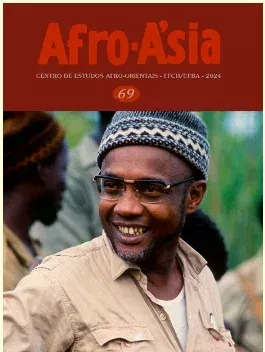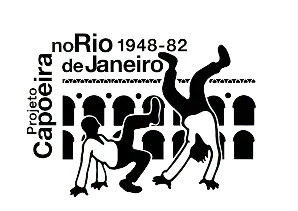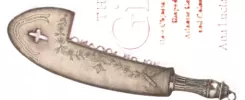Brasiliana: Black Culture on Stage (1949-73)
By Juliana Pereira e Matthias Röhrig Assunção
The Brazilian Folk Theatre (TFB) debuted in 1950 in Rio de Janeiro. It emerged from the association of a dissident group from the Teatro Experimental do Negro (TEN), led by Haroldo Costa and cultural entrepreneur Miécio Askanasy. The troupe managed to bring together composers, directors, choreographers, dancers, actors and singers – both leading professionals and amateurs, most of them black – and took on the role of discovering and training talent. Renamed Brasiliana in 1953, it was the first Brazilian group to show folkloric manifestations all over the world – from maracatu to capoeira – with more than 8,000 performances in more than 50 countries by 1968.
Theatre and Popular Culture
Popular and Afro-Brazilian culture had already been presented on stages in Rio since the second half of the 19th century in shows that took place in different spaces: in religious festival stalls, in circuses, in theatres and in the city’s small cafés. In the case of theatres, it was through the revue genre, a genre that combined music, dance and comedy, that these elements arrived on stage.
The revue theatre opened up a space for the representation of Afro-Brazilian culture in the theatrical universe and this black presence was always negotiated. In other words, even if black artists made it to the stage, they had to deal with prejudiced images that inferiorised the black population. Even so, these artists managed to negotiate, subvert and re-signify these stereotypes.
The ways in which black artists resisted on stage were diverse and some of them even managed to invest in international careers. Artists such as Plácida dos Santos, Geraldo Magalhães, Nina Teixeira and the group Oito Batutas, which included musicians Pixinguinha, Donga and João da Baiana, toured France, Portugal, Argentina and Uruguay, playing and dancing to Brazilian music.
For other subjects, resistance took the form of organising theatre companies. This was the case, for example, with the Companhia Negra de Revistas, founded in 1926 by black actor João Cândido Ferreira, better known as De Chocolat. And also of the Teatro Experimental do Negro (TEN), created by Abdias Nascimento in 1944, with the aim of advancing the black population and which contributed to the training of an important generation of actors for theatre, cinema, ballet and, in the future, television.
In different ways, these experiments aimed to give a leading role to black artists. Inspired by these groups, the Brazilian Folk Theatre/Brasiliana will develop this protagonism in an innovative way, largely breaking with previous experiences.
From the Grupo dos Novos to the creation of the Brazilian Folk Theatre (TFB)
At the end of 1949, a new theatre group was created in Rio de Janeiro: the Grupo dos Novos, made up mainly by dissident members of the Teatro Experimental do Negro (TEN). Led by actor Haroldo Costa and producer Miécio Askanasy, the following year the group was renamed the Brazilian Folkloric Theatre (TFB).
Haroldo Costa (1964)
Haroldo Costa is a multi-artist. Born in 1930 in Rio de Janeiro, as a child, after his mother’s death, he was sent by his father to Alagoas, where he was raised by his aunt. At the age of 10, he returned to Rio to live in Lapa. He participated in TEN activities, debuting in the play O Filho Pródigo (1947).
Miécio Askanasy (1950)
Photos from the Correio da Manhã Fund, deposited at the National Archives.
According to Askanasy and Costa’s recollections, the two met in the candomblé shrine of Joãozinho da Gomeia, in Duque de Caxias. Askanasy then started attending meetings of the Grupo dos Novos in the Largo do Machado neighbourhood and, realising that the group didn’t have a suitable space to rehearse, he offered his bookshop during the hours it was closed, from 6pm to 8pm. With more regular rehearsals, the dynamic changed, allowing the members’ talents to develop.
The group made its theatre debut in 1950 and the repertoire closely followed the actors‘, dancers’ and musicians’ roots in their respective regional black cultures. The scenes performed at the premiere were ‘Navio Negreiro’, ‘Brejeiro’, ‘Bahia’, ‘Funeral dum Rei Nagô’, ‘Batuque e Cateretê’, ‘Maracatu’ and ‘Macumba da Selva’. The scene ‘Bahia, 1835’ was inspired by a painting by Rugendas and included a capoeira game, which was probably the first time this art form was presented on a theatre stage, rather than in a fighting ring or in the streets.
The premiere was welcomed by a series of prominent critics and intellectuals, in particular the members of the Brazilian folklorist movement. After the success of their debut, the group finally managed to take off. The South American tour began in Argentina, where the owners of Teatro Astral, in Buenos Aires, demanded that they perform as Ballet del Brasil, instead of TFB. From there the group went to shows in several cities in the interior of Argentina. Afterwards, they went to Montevideo, Chile and Venezuela, from where they embarked for Europe.
The season in Europe began in Barcelona, at the beginning of 1953, and then it was the turn of Portugal, Italy, France, Belgium, Germany, Switzerland, Russia, England, Scotland, many Eastern European countries and North Africa. At that time the group changed its name to Brasiliana, easier for foreign audiences. In the international press, the group was praised for the originality of the show.
On its return to Brazil, in September 1955, Brasiliana was received with some enthusiasm by the Brazilian press. The newspaper highlighted that the group went from “amateurism” to “international stardom”.
“The greatest artistic embassy that has ever left Brazil returns, four years later, covered in glory” and “tour of 25 countries, visiting 250 cities” were some of the subtitles of an extensive article in the newspaper A Noite. The performance on the stage of the Theatro Municipal do Rio de Janeiro, shortly after their return, symbolized the hard-won professional recognition for these artists.
The triumphal return resulted in some success for Brasiliana as a company, but internal conflict over the direction changed the dynamics of the group. It resulted in the departure of Haroldo Costa and Miécio Askanasy remaining the overall manager of the group. The search for insertion in an increasingly competitive cultural industry also made Brasiliana adapt to an aesthetic common to many successful presentations of the time and move away from the community ideals of the initial amateur phase..
Still, by taking black folklore to the stage, Brasiliana went far beyond previous initiatives: in its performances, black folklore was presented as art, which dialogued with national and international artistic avant-gardes, in particular with transatlantic black modernism.

Brasiliana: Balé negro e performance no circuito transatlântico, 1949-73
Enjoy and read in full the article by Juliana Pereira and Matthias Röhrig Assunção, published in Revista Afro-Ásia, n. 69, 2024.
Juliana Pereira and Matthias Röhrig Assunção are part of the CapoeiraHistory.com team.
Other references:
Roberto Augusto Pereira, “Teatro Folclórico Brasileiro/Brasiliana: Teatro negro e identidade nacional”, Revista Transversos, Rio de Janeiro, n. 20 (2020), p. 216-238.




